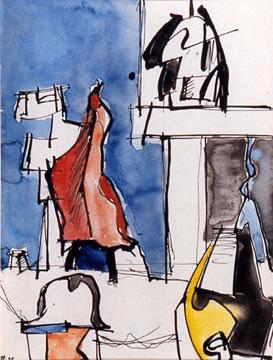Jean Helion
dal 14/7/2005 al 9/10/2005
Segnalato da
14/7/2005
Jean Helion
National Academy Museum, New York
A retrospective with about 35 paintings, including some of his favorite subjects: his model, street vendors, and still lifes with pumpkins. French painter who lived in the U. S. in the 1930s and 1940s, was an influential figure in the development of abstract art in America. He began his career as an exponent of European geometric abstraction, after World War II he devoted his art to representations with a strong emphasis on structure.

The National Academy Museum is pleased to serve as the only American venue for JEAN HÉLION (1904–1987), a retrospective of the influential French painter organized by the Centre Pompidou in Paris, currently on view at the Picasso Museum in Barcelona. Comprised of approximately thirty five works borrowed from European and American collections, including several key paintings created in the U.S, the exhibition will highlight Hélion’s connection to, and influence on the development of American art. (The artist lived in New York and Virginia between 1936 -1946, and was of key importance to both the American Abstract Artists and early Abstract Expressionists.) It will follow Hélion’s development from a geometric abstractionist of the 1930’s to his dramatic shift in the 1940’s to painting the figure, and his favorite subjects including the artist and his model, street vendors, and still lifes with pumpkins.
The exhibition, arranged chronologically, begins with a survey of the artist’s abstract oeuvre. Hélion emerged in the late 1920’s with geometric Compositions that closely resembled those of his colleagues, Mondrian and van Doesburg. After contact with Calder and Jean Arp however, his lines became less rigid, more curvilinear and he produced a series known as Circular Tensions. These works would ultimately give way to cubist compositions of voluminous interlocking planes of metallic colors.
Hélion wrote and lectured extensively on abstraction, and between 1932 -1945 had over 23 exhibitions in the US alone. American abstractionists such as Ad Reinhardt, John Ferren and others became acutely aware of his work and ideas, and were greatly influenced by them. He provided these American artists – those who were ready to leave American Scene painting and Social Realism behind - a theoretical framework to support their avant-garde explorations. Hélion was also influential on poets of the time including John Ashbery and Francis Ponge, and both have written frequently about him.
In 1939, much to the dismay of his friends and followers, Hélion closed the non-representational chapter of his career and turned to nature as a source of inspiration. He marked the occasion with a painting depicting a fallen figure, a symbolic as well as stylistic selection. In 1940 Hélion took part in WWII, the “phoney war†and was taken prisoner in a German camp in Stettin. He managed to escape and chronicled the events in his book, They Shall Not Have Me, published in the US in 1943.
In the 1940’s Hélion’s figuration was based on cubic and cylindrical forms, but in 1947 he painted à rebours (Wrong Way Up), a pivotal work that marks the artists move toward an art that draws most of its subject matter from the spectacle of life on the street. From this point on, Hélion devoted himself to capturing the everyday objects and people that surrounded and enchanted him. The figures that populate these canvases serve not only as models for the artist, but increasingly as allegorically charged archetypes. The exhibition will highlight this everyday prose that Hélion revisited time and again: the artist and his model, window displays, street vendors, men reading the newspaper and still lifes. The final part of the exhibition presents Hélion’s last works, in which his advancing blindness is counterbalanced by his sheer chromatic incandescence.
A small accompanying exhibition, HÉLION AND AMERICAN ART, will illustrate Hélion’s influence on American artists such as John Ferren, Leland Bell, Nell Blaine and others. Between 1932 and 1946 Hélion lived partly in America, developing close relationships with many in the New York artistic community. Instrumental in the formation of the American Abstract Artists group in 1936, Hélion played a seminal role in the genesis of geometric abstraction as practiced by artists such as George L. K. Morris, Carl Holty, Jean Xceron, and John Ferren, whose works are included in this exhibition. In the 1940s, Hélion's turn to figuration inspired a somewhat younger generation of artists who exhibited at New York's first artists' cooperative, the Jane Street Gallery, including Leland Bell, Louisa Mattiasdottir, Albert Kresch, and Nell Blaine. Like Hélion, they converted from an early allegiance to abstraction to develop a non-academic form of representation with a strong emphasis on structure. In bringing together the work of these artists who were all friends with Hélion, the exhibition will emphasize the role Hélion played in the development of American art in the 1930s and 40s.
Contemporary
Jean Hélion: Works on Paper
Tobor De Nagy Gallery, 724 5 Ave, Tel: 212.2625050, http://www.tibordenagy.com
Image: Spectacle, 1939 watercolor and ink on paper, 11 27/32 x 8 7/8 inches
National Academy Museum
1083 Fifth Avenue New York, NY 10128
Museum - Hours:
Monday - closed
Tuesday - closed
Wednesday - 12:00-5:00
Thursday - 12:00-5:00
Friday - 11:00-6:00
Saturday - 11:00-6:00
Sunday - 11:00-6:00
Closed on public holidays



